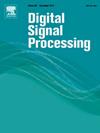在存在非线性失真的情况下,内置自标度核估计方法
IF 2.9
3区 工程技术
Q2 ENGINEERING, ELECTRICAL & ELECTRONIC
引用次数: 0
摘要
本文提出将谐波抑制的扰动信号与先验稳态增益相结合,用于估计非线性失真线性系统的脉冲响应。所提出的方法可以消除或减少非线性失真对线性估计的影响,并通过将基于标准核(KB)的公式直接扩展到内置自标度(BS)方法中,使先验信息能够纳入估计中。理论推导证明了该方法能保持扰动信号的谐波抑制特性。对脉冲响应估计中的偏差和方差进行了理论推导和详细分析。结果表明,该方法具有较高的估计精度和较低的不确定性,且不会增加计算复杂度和测量时间。此外,该方法可以很容易地扩展到多输入多输出系统。通过电子鼻的实际实验说明了所提出技术的可行性,其中响应在食品工业过程自动化中对于提高区分挥发性化合物的效率和可靠性非常重要。结果表明,该方法优于标准KB估计和利用先验稳态增益信息的竞争方法。本文章由计算机程序翻译,如有差异,请以英文原文为准。

Built-in self-scaling method for kernel-based estimation in the presence of nonlinear distortion
This paper proposes the use of perturbation signals with harmonic suppression in combination with prior steady-state gain for impulse response estimation of linear systems corrupted with nonlinear distortion. The proposed method allows the effects of nonlinear distortion on the linear estimate to be eliminated or reduced and enables the prior information to be incorporated into the estimation by a direct extension of the standard kernel-based (KB) formulation into the built-in self-scaling (BS) method. Theoretical derivation proves that the BS method can preserve the property of harmonic suppression in perturbation signals. The bias and variance in the impulse response estimate are derived theoretically and analyzed in detail. The findings confirmed that the proposed approach leads to high estimation accuracy and low uncertainty, without increasing computational complexity or measurement time. Furthermore, the method can readily extend to multi-input multi-output systems. The feasibility of the proposed technique is illustrated through a real experiment on an electronic nose, where the response is important in the food industry process automation for increasing both efficiency and reliability of distinguishing volatile compounds. The proposed approach was shown to be superior to both the standard KB estimation and a competing method utilizing information on the prior steady-state gain.
求助全文
通过发布文献求助,成功后即可免费获取论文全文。
去求助
来源期刊

Digital Signal Processing
工程技术-工程:电子与电气
CiteScore
5.30
自引率
17.20%
发文量
435
审稿时长
66 days
期刊介绍:
Digital Signal Processing: A Review Journal is one of the oldest and most established journals in the field of signal processing yet it aims to be the most innovative. The Journal invites top quality research articles at the frontiers of research in all aspects of signal processing. Our objective is to provide a platform for the publication of ground-breaking research in signal processing with both academic and industrial appeal.
The journal has a special emphasis on statistical signal processing methodology such as Bayesian signal processing, and encourages articles on emerging applications of signal processing such as:
• big data• machine learning• internet of things• information security• systems biology and computational biology,• financial time series analysis,• autonomous vehicles,• quantum computing,• neuromorphic engineering,• human-computer interaction and intelligent user interfaces,• environmental signal processing,• geophysical signal processing including seismic signal processing,• chemioinformatics and bioinformatics,• audio, visual and performance arts,• disaster management and prevention,• renewable energy,
 求助内容:
求助内容: 应助结果提醒方式:
应助结果提醒方式:


